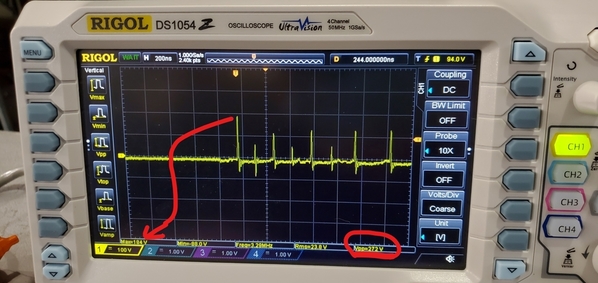stan2004 posted:Ryaninspiron posted:...To be clear, the scope is showing the voltage between the center-rail and outer-rail of a DCS layout? That is, the track is power by 18V AC and this is driving a 12V AC relay coil via the insulated-rail section? I set the track power to 12v for testing this. Besides that the scope is hooked to the rails, the relay was driven using a pin wire jumper that I touched to the same point as the scope probe. The EMF we see is on the track power after I lift the relay power wire off the track.
It's just that at 200 nsec per division, those spikes seem remarkably evenly-spaced as opposed to what would presumably be random interruptions in contact that I'd expect would be separated by more than ~100 nsec if a mechanically induced event. Stated differently, are you sure you're not measuring some kind of high-speed digital circuit signal somehow coupling into your measurement? It's my first time measuring EMF and it is certainly not a high speed digital circuit. Just the track connection point to a passive TIU channel.
Separately, as to your question about EMF and driving a relay. I believe you're addressing the issue of the so-called back-EMF spike when a relay coil quickly turns off such as intermittent wheel contact straddling an insulated-rail section. Exactly. Seems to me though that if this EMF spike is from the relay coil, then that spike is not on the track side and the TIU is "safe". This spike is on the track side. OTOH, if the EMF spike is from the inductance in the track (and the instantaneous interruption in current), then it seems to me you have far bigger problems. That is, a relay coil probably draws 1/2 Watt of power or, say, tens of mA at 12V. But an engine or even just a bulb lighted passenger car can draw tens or hundreds of times more current. In which case an intermittent loss of wheel contact would generate a spike in the thousands of Volts thru the same inductance!

Responses above, Thanks.
On your last point about why a light bulb does not create an equivalent spike, I thought a light bulb would be considered an almost purely resistive load and is quite a bit different from a relay coil in terms electron momentum. Not sure about locomotives though. Never did look for spikes on the scope wile they are running.





